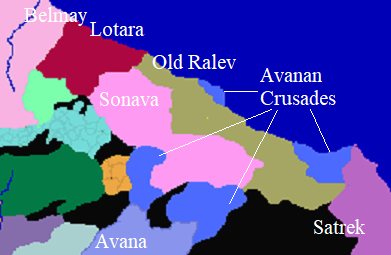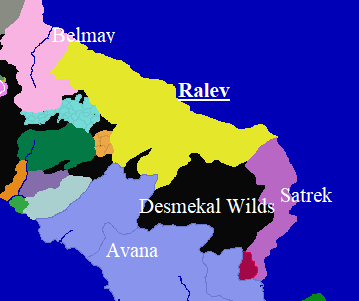Kingdom of Ralev
The Violet Star of Ralev rises above great hosts of marching monks and zealous warriors. Ralev is a rising power, a new kind of Desmian experiment based on a romantic past. The Kingdom of Ralev is a kingdom of warriors but not of knights - traditional feudalism is shunned, and common communities are seen as the basis for the military. This does not make Ralev a democracy, but rather a clan-based monastic theocracy led by a monarch, where everyone is expected to fight for their land. Ralev is on the march, struggling to return to an immaculate past. The people fight to restore the world to before the heresy, the invaders, and the monsters. This zeal can sometimes spill into neighbors fighting neighbors, but the small pockets of instability and monsters near the Desmekal Wilds tend to focus Ralev's attention and violence to a point. And when those pockets are finally extinguished, it is anyone's guess for where Ralev will march to sate their thirst for blood.
The symbol of Ralev is the "Lo-Monk" or the "Empty Monk" - the common footsoldiers of the monastic order, famous for their discipline and meritocracy. Where so much of Ralevan society is preoccupied with kinship or theology, the Lo-Monk cares only that the land is safe, the demons are slain, and their bodies are empty of evil. Lo-Monks are ascetics, with short hair (or entirely shaved heads) and affordable arms and armor. Their glaives, short-swords, and red-circles-on-grey-cloth robes mark them wherever they go. Anyone, no matter how low, can become a Lo-Monk, as long as they surrender to the Struggle.
Structure
Ralev is ruled by a powerful monarch who manages the formal military and tax system. There is no formal aristocracy here, but rather an extremely powerful priesthood and system of 'Monastic Feudalism'. Local monasteries, led by an Abbess or Abbot, manage the countryside in the place of local lords. These monasteries focus on local military production and self-sufficiency, and tend to be rather autonomous.
The rural lands are divided into large provinces known as "Hegumenos", led by the arch-abbots or 'Hegumen'. These Hegumen are elected from the local Abbots as for-life positions. The Hegumen in turn elect the Archimandrites, or head monks, who represent the Lo-Monks in royal government. The priests have their own parallel system, which operates in a similar way - temples meet annually in regional conclaves to elect First Among Equals, who then represent that region in Ralev's regional high church, or 'Ecclesia'. To name an heir, two out of three of the monarch, Archimandrites, and Ecclesia must agree on the candidate - theoretically leading to only the most qualified of the royal family holding the throne.
The current King is Henibar I, who is well loved and widely respected. Henibar's success is largely the success of the kingdom despite him - he is a skilled administrator, but an abysmal diplomat and general; his temper is great, his charisma is like wet cardboard, he lacks ambition, and he is a mediocre fighter and theologian. But as a very conservative and patient master of coin with an eye for talent greater than him, he is just the ruler Ralev needs right now - and his flaws are regarded with affection while the country thrives.
Culture
Food Culture: Hearty and Balanced
Family Matters: Kinship and Ralev
History
Ancient History (-200 DE to 1519 ME)
The Lotaran Crusades (1519 - 1840)
A New Ralev Emerges (1840 - Present)
Demography and Population
Territories
Ralev is 500 miles long and around 250 to 300 miles inland. In the Southeast are the Desemkal Wilds - mountains inhabited by Ishkibite mountain clans and infested with Kivish and monsters. The Western border is entirely marked by the Kulindra mountains, which include pockets of bandit fiefs, Kivish remnants, and Feywild exiles.
Military
The Ralevan military is a glorious experiment, though it seems to be going fairly well so far. Each village is set up and encouraged to act like a potential military regiment: they not only train relentlessly like most other Orthodox states, but work to try and produce their own weapons and armor. The hope is that any region could, at a moment's notice, rise up and organize itself into a fully fledged army. The monks are the shock troops of this decentralized eternal army, acting as specialists, disciplined frontliners, and officers. In theory, this great rural mass of militarized Desmians will then be supplemented with urban specialist divisions, creating a truly enormous army at minimal cost.
What this translates to is a very large, very difficult to control army that sits somewhere between professional standing army and militia. The majority of these forces are light infantry, skirmishers, and light cavalry - the focus is on spears, arrows, and lancers. The Lo-Monks, meanwhile, vary in their specialty but can vary from sharpshooters to heavy infantry to spellcasters.
A taboo and semi-secret element of Ralev's military is their use of "Binders". Traditionally, the idea of a Binder-Magician is a Belmayan idea (ie from the kingdom to Ralev's North) that relates to keeping Dryads or other "demons" captive for military purposes. While Belmayan "Binding" focuses on traditional "demons", Ralevan "binding" is less obvious and more personal: the use of paladins, who forge contracts with the 'Demonic' Lunar Pantheon, most often with Theia the Liberator. These paladins are also permitted to keep or use Kivish Ederstone-spawn for war, though such instances are extremely rare.
Religion
Orthodox Desmianism is very strong in Ralev. The spirit of crusading is alive and well here, with the constant threat of Kivish, Ederstone monsters, and raiders inspiring a constant sense of danger that can only be answered with religious violence. All elements of society are religious - monks and priests manage the government, and it is impossible to avoid a temple while living here. Granted, many of these communities are low-key Ishkibite, and have been silently tolerated since the Kivish wars of the 1800s. This toleration has gaps where it spills into inter-community violence, but that is rare and often involves other factors (such as resource competition).
There is a strange 'mysticism' of the Struggle in Ralev that some have labeled 'quasi-Seruviani': that holy war has a spiritual healing property, a way to heal the land and its people. The crimes of the past can be literally magically reversed through purifying violence - or at least that is what many believe (perhaps more accurately, what they desperately hope).
The most popular ancestor in Ralev is Relia the Star Empress, founder of the first Kingdom of Ralev and she who lifts commoners into priests and heroes. Olaina the Silver (also known as Olaina Silver-tongue) is another common one, a representation of unity, magical power, and the archetypal Lo-Monk.
Foreign Relations
Ralev is a rising Orthodox power tentatively allied to the The Holy Republic of Pakray against their neighboring rival, the Empire of Avana. Ralev has also reached out to and courted the neighboring Kingdom of Belmay, seemingly in hopes of creating a regional power bloc.
Agriculture & Industry
The vast majority of Ralev is agricultural. Wheat, rice, and maize are all extremely common crops here. Small-scale herding of sheep, horses, and cattle is common. Small mining operations and lumber mills also dot the countryside. Only recently has Ralev dropped a proper manufacturing base to process these raw resources - but the towns and cities are flourishing now. Textiles and smithing are the big rising industries along the coast, along with whaling and shipbuilding.
Trade & Transport
Most trade is managed by the Great Clans: massive extended families that sprawl across and out of the country. These Great Clans rely on large networks of lesser clans, who they often marry into - creating a massive, complicated network of families and sub-families that can be extremely difficult for an outsider to navigate. This web extends into guild leadership and city leadership - and local priests or monks often end up playing powerbroker in the middle.
Education
Temples handle most of the common education, providing basic literacy and religion lessons to all Orthodox and Ishkibite children. The College of Senrail provides more advanced education for interested priests - though, The Holy Republic of Pakray has shown great interest in opening new universities along the coast.
"We Shall Restore the World"
Founding Date
1841
Type
Geopolitical, Kingdom
Demonym
Ralevan
Government System
Monarchy, Theocratic
Power Structure
Feudal state
Currency
Asalay Dungeon Coinage: Gold Dragons, Silver Eagles, and Copper Bulls
Major Exports
Lumber, Iron, Tar, Textiles
Major Imports
Spices, glass
Official State Religion
Location
Official Languages
Neighboring Nations
Remove these ads. Join the Worldbuilders Guild





Comments